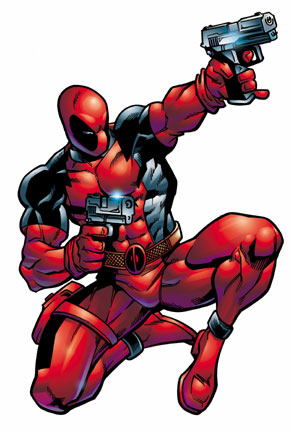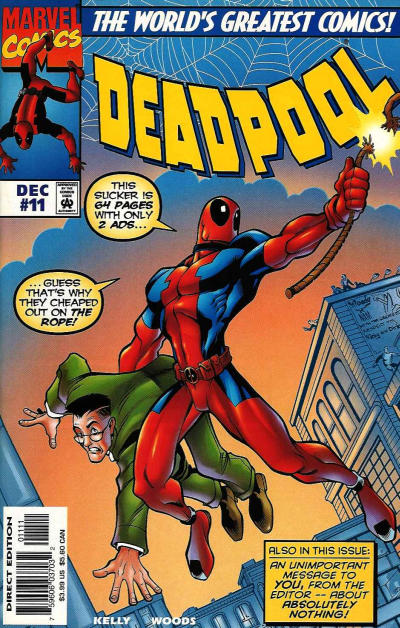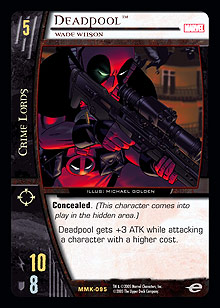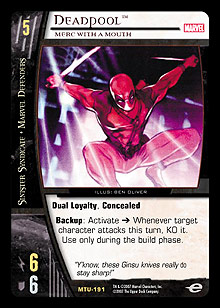This week, Living Ink will focus on one of my favorite characters in the Marvel universe. In fact, very few characters in any comic book universe tickle my fancy as much as the “Merc With a Mouth,” Deadpool.
I regularly lend out my copies of the early part of Deadpool’s ongoing series, which commenced in 1997 and ran until #69 in 2002, because I’m constantly trying to spread the love for Wade Wilson. These issues can be difficult to find, and even the collected edition of the first five issues (Deadpool: Mission Improbable TPB), seems somewhat rare.
Every single person who has read these comic books on my recommendation has been a 100% satisfied customer. I normally don’t like to make generalizations, but I am almost willing to suggest that anyone who doesn’t like these Deadpool stories doesn’t really like super hero stories. Joe Kelly and Ed McGuiness’s take on the character in those issues was pitch-perfect and cemented Deadpool as a heroic figure, albeit a twisted and often homicidal one. Arguably for the first time, these creators gave Wade Wilson depth and credible motivation . . . while not diminishing his traditional shtick. They introduced a tragic element to ’Pool’s makeup that made you care about the character while still cracking you up with his slapstick shenanigans month after month.
So who is this man called Deadpool? The Merc With a Mouth was created by controversial plotter/artist Rob Liefeld and writer Fabian Nicieza, and first appeared in The New Mutants #98, published in February 1991. He was initially an adversary for Cable and the young group of mutants he led, best known as X-Force. Deadpool’s early appearances generated a lot of excitement among fans, and he was subsequently given his own limited series in 1993 entitled Deadpool: The Circle Chase. A second limited series entitled Deadpool: Sins of the Past was published in 1994. After many high profile guest appearances around the Marvel universe, Deadpool received the aforementioned ongoing series.
Mixing manic (and often juvenile) humor with a healthy helping of mayhem and murder, Deadpool is to mercenaries what Spider-Man is to heroes. He is a prankster—a hyper-kinetic and usually overly verbose character who infuriates opponents and amuses readers. Deadpool’s wit is sharp but typically lowbrow, making his antics something of a guilty pleasure.
A self-proclaimed “arrogant, dolphin hating, hippie-kicking” merc (Deadpool #1), Deadpool is a walking, talking contradiction. On one hand, according to Overseer Dixon in Deadpool #1, Wade has been “personally responsible for more suffering and carnage than your average cholera outbreak,” but on the other, he has also saved the world a couple of times. He is prone to dark, menacing moods and uncontrollable fits of violence, as well as the zaniest behavior you’re likely to see outside of a Looney Tunes episode. Deadpool is a self-loather who feels ugly, not only because of the horrible scarring of his face and body, but also because of the evil acts he has performed throughout his bloody career as a mercenary and assassin. His use of slapstick, and his unsettling appreciation of Happy Meal toys and Bea Arthur (of Golden Girls fame), could be explained as part of a bizarre set of coping mechanisms.
It has been noted by more than one fanboy that Deadpool shares more than a few superficial characteristics with DC’s supreme assassin, Deathstroke the Terminator, Slade Wilson. But apart from their shared profession, similar hero names, and almost identical civilian names, the characters are very different. If anything, Deadpool is more like a funhouse-mirror reflection of the grittier DC hit man. If Deadpool was ever intended as an homage to Slade Wilson, he has long since taken on a life of his own.
Another unique element of Deadpool’s character is the regularity with which he “breaks the fourth wall” in his comic appearances. The fourth wall is the separation between the fiction and the audience. For example, the characters in a traditional play are not aware of the audience, nor are they aware of the fact that they are in a play. Similarly, Superman doesn’t know that he is a comic book character and that there are hundreds of thousands of readers enjoying his adventures on a monthly basis. Deadpool is one of the few Marvel characters that break this fourth wall, often talking directly to the reader and regularly making references to the fact that he is in a comic book. For example, Wade repeatedly stated, “None of this is really happening. There is a man. With a typewriter. This is all part of his crazy imagination.” during writer Christopher J. Priest’s run on Deadpool. The characters around Deadpool never appear to consider the implications of these revelations, but this might just be because Wade is nuttier than a squirrel’s lunch and no one takes anything he says seriously. In fact, it has been theorized that his ability to perceive the fourth wall is a direct result of his insanity
In terms of super powers, Deadpool has an artificial healing factor derived from and similar to that of Wolverine’s. It allows him to regenerate damaged or destroyed parts of his body at an extraordinary rate, enabling him to re-grow vital organs or even severed limbs.
 Before he was Deadpool (but after having already established himself as a highly skilled mercenary), Wade was driven by desperation into the clutches of Department K and their infamous Weapon X program after being diagnosed with terminal cancer. The subsequent gene therapy resulted in his cancer and the healing factor becoming inexplicably fused together. This means that Wade’s cancer is in essence his healing factor, which is why his skin is still horrifically scarred. One side effect of his healing power is that his brain cells are in a constant state of flux and regeneration; this makes him immune to psychics. It is also a possible explanation for his insanity. Other by-products of Deadpool’s healing factor are enhanced strength, stamina, agility, and reflexes, as well as a virtual immunity to poisons and most drugs.
Before he was Deadpool (but after having already established himself as a highly skilled mercenary), Wade was driven by desperation into the clutches of Department K and their infamous Weapon X program after being diagnosed with terminal cancer. The subsequent gene therapy resulted in his cancer and the healing factor becoming inexplicably fused together. This means that Wade’s cancer is in essence his healing factor, which is why his skin is still horrifically scarred. One side effect of his healing power is that his brain cells are in a constant state of flux and regeneration; this makes him immune to psychics. It is also a possible explanation for his insanity. Other by-products of Deadpool’s healing factor are enhanced strength, stamina, agility, and reflexes, as well as a virtual immunity to poisons and most drugs.
In addition to his super powers, Deadpool is also a superbly skilled hand-to-hand combatant, an extraordinary swordsman, a master of assassination techniques, and an excellent marksman. Deadpool also utilizes a teleportation device located in his belt to transport himself to and away from his targets, and he’s been seen to use a holographic image inducer to disguise himself (both on missions and during down time).
Deadpool was first seen as an assassin in the employ of the mysterious Mr. Tolliver (who was later revealed to be Cable’s evil son, Genesis), but he has worked for the Kingpin and just about anyone else who is willing to pony up the cash. This established Deadpool as a genuine villain, but later appearances cast him as more of an anti-hero. While he operates under his own—sometimes suspect—morality, there is more than just a little bit of good in Wade. He even has friends, including Weasel and Blind Al, to whom he is loyal and cares about . . . although this doesn’t stop him from stabbing Weasel in the leg over the last cheesy poof or pulling cruel pranks on the sightless Al.
While fanboys and girls worldwide know that Deadpool’s real name is Wade Wilson, it has been revealed that this, too, is an assumed identity. A young mercenary named Jack willingly signed up for assassination jobs on targets he felt deserved death. After failing one of these missions, though, Jack was pursued and seriously injured by his angry employers. He was found and nursed back to health by a young couple, Wade and Mercedes Wilson. Jack decided to assume Wilson’s identity and attacked his host, leaving him for dead. In the process, he accidentally killed Mercedes, which apparently unhinged him. Jack became convinced that he truly was Wade Wilson and eventually became Deadpool. Confused much? This all came to a head when it was revealed that the real Wade Wilson survived Jack’s attack and went on to become a mercenary himself. Calling himself T-Ray, Wilson worked alongside Deadpool in the Hell House and plotted his revenge.
Sometime before contracting cancer and becoming Deadpool, Wade (forgetting the fact that this wasn’t really his name) was identified by inter-dimensional firm Landau, Luckman, Lake, and LeQuare as potentially being the “Mithras,” the one who would help usher in a golden age for Earth. While many in the firm believed putting such faith in Deadpool was foolhardy, agent Zoe Culloden believed that Wade would redeem himself and embrace his heroic destiny. In the end, though, his “destiny” was to kill a being named Tiamat, who threatened an arriving “Messiah.” Learning that the Messiah was essentially going to enslave humanity by placing them in a state of mindless bliss, Deadpool killed him instead. This crushed Wade’s newfound optimism, and he backslid to his murderous mercenary ways.

A major highlight in Deadpool’s solo title was issue #11, in which Deadpool and Blind Al are “gumped” into Amazing Spider-Man Vol. 1 #47, originally published in 1967. Accidentally transported back in time, their only hope for returning to their present is to get in touch with the 1967 version of Weasel and get him to fix them up with a technological solution. Deadpool disguises himself as Peter Parker using his holographic projector, while the real Peter is sent on a wild goose chase. With Deadpool in the place of Spidey and Blind Al in the place of Aunt May, they insinuate themselves into the thirty-year-old story. The creators airbrushed over the original characters and changed some words (in addition to adding a couple of original touches) to create a crazy new adventure.
After Deadpool #69, the series was wrapped up and re-launched with the title Agent X. It was originally hinted that the title character in this series was an amnesiac Deadpool, but it was later revealed that this was not the case.
More recently, Deadpool has joined former adversary Cable in an often tense team-up in the pages of Cable & Deadpool. This series is nearing the forty-issue mark, and has had a significant impact on major storylines, including Civil War. During the first story arc, If Looks Could Kill (Cable & Deadpool #1–6), Deadpool is hired by the One World Church, which preaches homogeny and conformity as a means of achieving world peace, to steal a virus that will allow them to break down racial and cultural boundaries by turning everyone blue. Through a series of events, both Cable and Deadpool meet and then battle at the One World Church and are each infected by the virus. In order to save them both, Cable merges his and Deadpool’s bodies. They are soon separated, but their DNA is mixed. Cable saves the day, but in doing so, establishes himself as a potential threat to the organization. Because of  the mixing of their DNA, both Cable and Deadpool can teleport using Cable’s “bodyslide” device, but when one does it, he takes the other with him, forcing this odd-couple to interact and cooperate more than either would prefer.
the mixing of their DNA, both Cable and Deadpool can teleport using Cable’s “bodyslide” device, but when one does it, he takes the other with him, forcing this odd-couple to interact and cooperate more than either would prefer.
Deadpool fans have been treated to just two versions of our favorite mercenary menace in Vs. System.
Deadpool, Wade Wilson was the first version of the character, created as a 5-drop for the Crime Lords team in the Marvel Knights expansion. While Wade can be most accurately described as a loner, his mercenary attitude means that his loyalties can usually be bought. Having been employed by the Kingpin repeatedly in the past, I think it’s quite appropriate for him to be affiliated with any team on which Wilson Fisk is a key member. Being concealed represents Deadpool’s stealthy skills as an assassin, while aggressive stats and a +3 ATK bonus for attacking up the curve reflect his awesome fighting prowess.
 Deadpool, Merc With a Mouth is also a 5-drop, but this time Deadpool features as one of the powerful dual loyalty character in Marvel Team-Up. Here, Wade is on the Sinister Syndicate and Marvel Defenders teams. As with the above, affiliating ’Pool with the Syndicate is appropriate from a flavor perspective because he’s worked alongside many Spidey villains. As for the Marvel Defenders, it is a little known fact that Deadpool was among a number of characters who served as part of the Secret Defenders on an ad hoc basis. This Deadpool also has concealed, again reflecting his stealthiness. As for his backup power, it similarly emphasizes Wade’s assassination skills. I desperately want to recruit this card in a game and use one of those laser pointers to put a red dot on whichever character finds itself in Deadpool’s crosshairs.
Deadpool, Merc With a Mouth is also a 5-drop, but this time Deadpool features as one of the powerful dual loyalty character in Marvel Team-Up. Here, Wade is on the Sinister Syndicate and Marvel Defenders teams. As with the above, affiliating ’Pool with the Syndicate is appropriate from a flavor perspective because he’s worked alongside many Spidey villains. As for the Marvel Defenders, it is a little known fact that Deadpool was among a number of characters who served as part of the Secret Defenders on an ad hoc basis. This Deadpool also has concealed, again reflecting his stealthiness. As for his backup power, it similarly emphasizes Wade’s assassination skills. I desperately want to recruit this card in a game and use one of those laser pointers to put a red dot on whichever character finds itself in Deadpool’s crosshairs.
In some respects, I think the artwork for the two versions of Deadpool would be more appropriate if they were switched. The Wade Wilson image is a classic sniper image, while Ben Oliver’s beautiful work on Merc With a Mouth shows ’Pool playing with his favorite sharp objects.
As with Venom last week, I think there is a lot of potential for future development of Deadpool characters in Vs. System. While providing a high coolness factor, Deadpool’s current character cards have yet to highlight the zaniness of the character. Also, his regenerating and teleporting capabilities have yet to be explored. While it can be challenging to categorize Deadpool onto Vs. System teams in a flavorful way, I hope the scope for further development means that there are more versions of my favorite Merc to come in the not too distant future.
Finally, please find below a short recommended reading list regarding Deadpool:
- New Mutants Vol.1 #98–100 and X–Force #1–4 (1991) – First and early appearances (note that Deadpool did not appear in each of these issues, but the numbering is included for the sake of continuity)
- Deadpool: The Circle Chase #1–4 (1993) – First limited series (republished as a TPB)
- Deadpool: Sins of the Past #1–4 (1994) – Second limited series (republished as a TPB)
- Secret Defenders #15–17 (1994) – Deadpool briefly joins the Marvel Defenders
- Deadpool #1–5 (1997) – Deadpool vs. the Hulk in #4 (republished in Deadpool: Mission Improbable TPB)
- Deadpool #11 (1998) – Deadpool “gumped” into Amazing Spider-Man Vol. 1 #47
- Cable & Deadpool #1–6 (2004) – Republished in Cable & Deadpool Vol. 1: If Looks Could Kill TPB
Hopefully, Marvel will considering releasing even more of Deadpool’s earlier adventures in collected form; I’m confident there would be significant demand for them.
See you in the funny pages,
Michael Pittman
ikeebear@hotmail.com